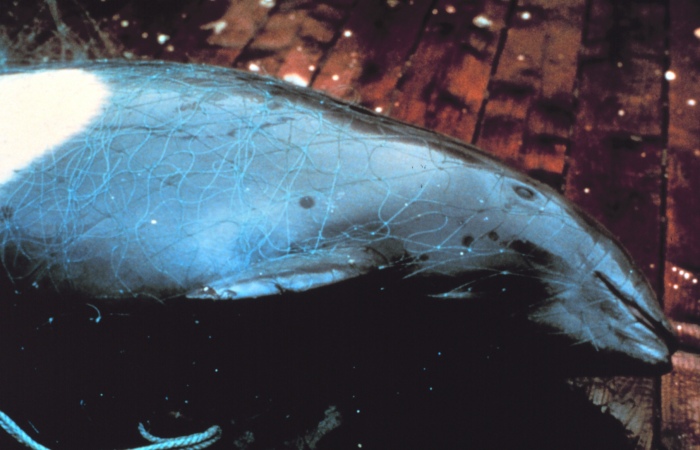List of Fisheries (LOF)
Background | Classification Criteria | Categories | List of Fisheries PDFs | Reporting Requirements | Requirements for Category I and II Fisheries | Additional Information
Background |
| Entangled Dall's Porpoise (Phocoenoides dalli) Photo: NOAA |
Fishery Classification Criteria
NOAA Fisheries has developed and implemented fishery classification criteria, which consists of a two-tiered, stock-specific approach. This two-tiered approach first addresses the total impact of all fisheries on each marine mammal stock and then addresses the impact of individual fisheries on each stock. This approach is based on the rate, in numbers of animals per year, of incidental mortalities and serious injuries of marine mammals due to commercial fishing operations relative to a stock's Potential Biological Removal (PBR) level. The PBR level is defined in 50 CFR 229.2 as the maximum number of animals, not including natural mortalities, that may be removed from a marine mammal stock while allowing that stock to reach or maintain its optimum sustainable population.
Tier 1:
- If the total annual mortality and serious injury across all fisheries that interact with a stock is less than or equal to 10 percent of the PBR level of this stock, all fisheries interacting with this stock would be placed in Category III. Otherwise, these fisheries are subject to the next tier of analysis to determine their classification.
Tier 2:
- Category I: Annual mortality and serious injury of a stock in a given fishery is greater than or equal to 50 percent of the PBR level.
- Category II: Annual mortality and serious injury of a stock in a given fishery is greater than 1 percent and less than 50 percent of the PBR level.
- Category III: Annual mortality and serious injury of a stock in a given fishery is less than or equal to 1 percent of the PBR level.
While Tier 1 considers the cumulative fishery mortality and serious injury for a particular stock, Tier 2 considers fishery-specific mortality for a particular stock. Additional details regarding how threshold percentages between the categories were determined are provided in the preamble to the final rule implementing section 118 of the MMPA (60 FR 45086 [pdf], August 30, 1995).
Since fisheries are categorized on a per-stock basis, a fishery may qualify as one Category for one marine mammal stock and another Category for a different marine mammal stock. A fishery is typically categorized on the LOF according to its highest level of classification (e.g., a fishery that qualifies for Category III for one marine mammal stock and Category II for another marine mammal stock will be listed under Category II).
How Do I Find Out if a Specific Fishery is in Category I, II, or III?
The LOF includes two tables that list all U.S. commercial fisheries by Category. Table 1 lists all of the fisheries in the Pacific Ocean (including Alaska). Table 2 lists all of the fisheries in the Atlantic Ocean, Gulf of Mexico, and Caribbean.
Lists of Fisheries
(All documents in the table below are in PDF format.)
- 2005 Environmental Assessment on the LOF [pdf] [410 KB]
Am I Required to Submit Reports When I Injure or Kill a Marine Mammal During the Course of Commercial Fishing Operations?
Any vessel owner or operator, or fisher (in the case of non-vessel fisheries), participating in a Category I, II, or III fishery must comply with 50 CFR 229.6 and report all incidental injuries or mortalities of marine mammals [pdf] that occur during commercial fishing operations to NMFS. "Injury" is defined in 50 CFR 229.2 as a wound or other physical harm. In addition, any animal that ingests fishing gear, or any animal that is released with fishing gear entangling, trailing, or perforating any part of the body is considered injured and must be reported.
Requirements for Category I and II Fisheries
Registration
Owners of vessels or gear engaging in a Category I or II fishery, are required under 50 CFR 229.4 to obtain a marine mammal authorization by registering with the Marine Mammal Authorization Program (MMAP). You must register through a NMFS Regional Office unless you participate in a fishery that has an integrated registration program. Upon receipt of a completed registration, NMFS will issue vessel or gear owners a decal to display on their vessels and an authorization certificate that must be in the possession of the operator while fishing. The procedures and fees associated with registration differ between Regions.
For some fisheries, NMFS has integrated the MMPA registration process with existing state and Federal fishery license, registration, or permit systems and related programs. Participants in these fisheries are automatically registered under the MMPA and are not required to pay the $25 registration fee.
Observers
Fishers participating in a Category I or II fishery are required to accommodate an observer onboard your vessel(s) upon request. Observer requirements can be found in 50 CFR 229.7.
Take Reduction Planning
Fishers participating in a Category I or II fishery are required to comply with any applicable take reduction plans. NMFS may develop and implement take reduction plans for any Category I or II fishery that interacts with a strategic stock.
- Marine Mammal Stock Assessment Reports (SARs)
- Serious Injury Technical Workshop (2007)
- GAMMS Workshop Report (2005): Guidelines for Preparing SARs [pdf]
- Serious Injury Workshop Report (1997): Differentiating Serious and Non-Serious Injury of Marine Mammals Taken Incidental to Commercial Fishing Operations [pdf]